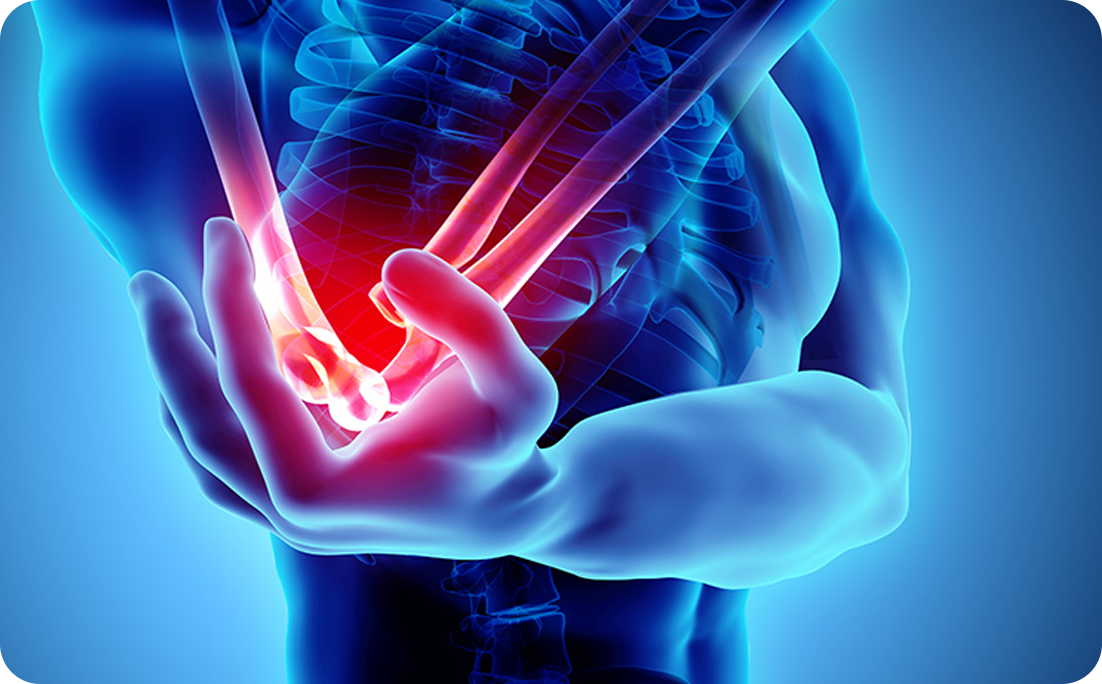Elbow pain
Elbow pain may come and go, worsen with activity, or be constant. It could be acute or excruciating pain, as well as tingling or numbness in your arm and hand. Sometimes elbow pain is caused by an issue with your neck, upper spine, or shoulder.
Many elbow disorders necessitate clinical treatment by a doctor or other health care expert.
Other sorts of elbow disorders normally do not necessitate clinical treatment or surgical intervention. They may be self-healing or self-treated.
What is cubital tunnel syndrome?
Cubital tunnel syndrome develops when the ulnar nerve, which runs through the cubital tunnel (a muscle, ligament, and bone tunnel on the inside of the elbow), is injured and becomes inflamed, swollen, and irritated.
What are the symptoms of cubital tunnel syndrome?
The most prevalent symptoms of cubital tunnel syndrome are as follows. However, each person's symptoms may differ.
Symptoms may include:
- Numbness, tingling, discomfort, and muscle weakness in the afflicted arm and hand.
- Pain on the inside of the elbow.
How is the cubital tunnel syndrome treated?
The most effective treatment for cubital tunnel syndrome is to discontinue the activity that is causing the issue. Treatment options may include:
- Resting and avoiding aggravating activities like bending the elbow.
- Use a splint or foam elbow brace at night to reduce mobility and irritation.
- Use an elbow pad to prevent chronic irritation from rough surfaces.
- Anti-inflammatory medications (e.g., ibuprofen, naproxen).
- Nerve gliding exercises.
If these therapies do not work, your healthcare professional may inform you about:
- Steroid injections to alleviate swelling and pain.
- Surgery.
Golfer's Elbow or Baseball Elbow (Medial Epicondylitis)
Golfer's elbow is a painful condition caused by the tendons of your forearm muscles attaching to a bony protrusion on the inside of your elbow. The pain could move to your forearm and wrist.
Golfer's elbow is similar to tennis elbow, however it occurs on the outside of the elbow. It's not just golfers.
Tennis players and others who use their wrists or clench their fingers frequently can develop golfer's elbow.
When to visit a doctor.
Consult your doctor if rest, ice, and over-the-counter pain medicines do not alleviate your elbow pain and tenderness. Seek emergency medical attention if your elbow is heated, inflamed, unable to bend, appears misshapen, or you fear you have broken a bone.
Causes
Golfer's elbow, also known as medial epicondylitis, is caused by injuries to the muscles and tendons that govern your wrist and fingers. The injury is usually caused by excessive or recurrent stress, particularly strong wrist and finger motions. Golfer's elbow can also be caused by improper lifting, pitching, or hitting, as well as a lack of warmup or conditioning.
Aside from golf, several activities and vocations can cause golfer's elbow, such as:
Racket sports. Throwing sports. Weight training.
Treatment for Medial Epicondylitis
The treatment for medial epicondylitis includes discontinuing the activity that causes the symptoms. It is critical to prevent the movement that produced the problem in the first place. Treatment options include ice packs, strengthening exercises, anti-inflammatory medications, bracing, corticosteroid injections, and surgery (in rare cases).
What is tennis elbow?
Lateral epicondylitis, often known as tennis elbow, is a swelling of the tendons that bend your wrist backward away from your hand.
A tendon is a tough strand of tissue that connects muscles and bones. The tendon most likely involved in tennis elbow is known as the extensor carpi radialis brevis. Tennis elbow is commonly diagnosed in men and women between the ages of 30 and 50.
Symptoms
Tennis elbow pain can spread from the outside of the elbow to the forearm and wrist. Pain and weakness might make it difficult to perform tasks like shaking hands, turning doorknobs, and holding a coffee cup.
How is tennis elbow treated?
It's critical to prevent the movement that produced the injury in the first place. Treatment options may include:
- Resting and avoiding the symptom-causing activity, as well as applying ice packs to relieve inflammation.
- Strengthening and stretching exercises
- Anti-inflammatory medications (e.g., ibuprofen, naproxen)
If these treatments do not work, your healthcare professional may recommend bracing the affected area for a few weeks or using a specific brace during activities.
- Steroid injections to alleviate swelling and pain
- Ultrasound to break up scar tissue, boost blood flow, and promote healing.
- Surgery is rarely necessary.
Case Study By

Dr Nishant Soni
(MBBS, MS-Ortho)
Experience
Hand & Reconstructive
Micro Surgeon with 13 yrs
as specialist
Work in Stats till 2023
5000+ Carpal Tunnel Surgery
10010+ Hand Fractures
3000+ Wrist Surgeries
40000+ Happy Patients
Associations
Medanta MedCity
SCI International Hospital
Medanta MedCity
SCI International Hospital
Read More


